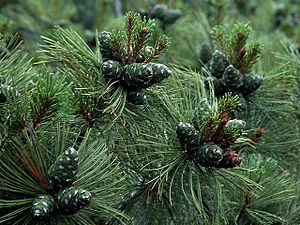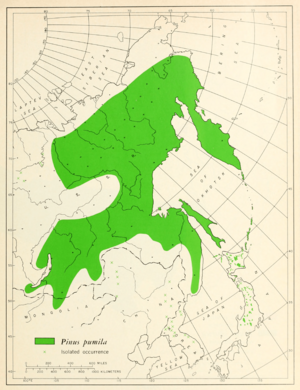Siberian dwarf pine facts for kids
Quick facts for kids Siberian dwarf pine |
|
|---|---|
 |
|
| Conservation status | |
| Scientific classification | |
| Genus: |
Pinus
|
| Species: |
pumila
|
| Synonyms | |
|
|
The Pinus pumila, also known as the Siberian dwarf pine, is a special type of tree in the Pinaceae family. It is originally from northeastern Asia and the Japanese islands. People also call it the dwarf Siberian pine, dwarf stone pine, Japanese stone pine, or creeping pine.
Contents
What is the Siberian Dwarf Pine?
The Siberian dwarf pine is an evergreen shrub, which means it keeps its green leaves all year round. It usually grows to be about 3 to 10 feet (1 to 3 meters) tall. Sometimes, it can reach up to 16 feet (5 meters). Its branches can spread out even further along the ground.
In the mountains of northern Japan, this pine sometimes mixes with another related tree called the Japanese white pine (Pinus parviflora). When they mix, they create a new type of tree called Pinus × hakkodensis. These mixed trees can grow taller than the Siberian dwarf pine, sometimes reaching 26 to 33 feet (8 to 10 meters) tall.
The leaves of the Siberian dwarf pine are like needles. They grow in groups of five and are about 1.5 to 2.5 inches (4 to 6 centimeters) long. The cones, which hold the seeds, are about 1 to 1.7 inches (2.5 to 4.5 centimeters) long. Inside the cones are large seeds that look like nuts, known as pine nuts.
Where Does It Grow?
The Siberian dwarf pine grows in many places across Asia. You can find it in the Far East, Eastern Siberia, northeastern Mongolia, northeastern China, northern Japan, and Korea.
This pine often grows in mountain areas, especially above the tree line. The tree line is the highest point on a mountain where trees can still grow. Here, the Siberian dwarf pine forms thick, dense groups. It also grows on the headlands (parts of land sticking out into the sea) along the Okhotsk and Bering Seas, and the Pacific coast.
The Siberian dwarf pine grows very slowly. It can live for a very long time, sometimes up to 300 years, and in some cases, even 1,000 years! In the very cold parts of Siberia, some of these trees are 250 years old or more.
How Does It Spread Its Seeds?
The seeds of the Siberian dwarf pine are an important food source for a bird called the spotted nutcracker (Nucifraga caryocatactes). This bird helps the pine tree by collecting and spreading its seeds. When the nutcracker buries seeds to save them for later, some of those seeds grow into new pine trees.
Growing Siberian Dwarf Pine
People sometimes grow the Siberian dwarf pine in parks and gardens because it is a beautiful plant. It is used as an ornamental shrub, which means it's grown for its looks. There is a special type of Siberian dwarf pine called P. pumila 'Glauca'. This type has won an award from the Royal Horticultural Society for being a great garden plant.
Images for kids
See also
 In Spanish: Pino enano siberiano para niños
In Spanish: Pino enano siberiano para niños







